|
Sylvester Stallone is scheduled to begin the production of a new movie about Formula One, the first film to be done on the sport since John Frankenheimer's movie "Grand Prix", which was filmed during the 1966 season. By coincidence or design, Grand Prix seems to be enjoying a renaissance itself; the movie has been aired recently on several TV stations around the world, and is also now available on home video. In a two part article, Thomas O'Keffe explores the legacy of "Grand Prix" and the possibilities for Stallone to repeat the success of the earlier movie.
Part I
The Ferrari stalls out on the grid in the last race of the season, with the Ferrari driver sitting second in the points and in a position to win the World Championship. Is it Suzuka in 1998 with Michael Schumacher's clutch letting go? No, its art imitating life or vice-versa: it's the closing sequence in John Frankenheimer's 1966 classic Formula One movie "Grand Prix".
 John Paul Sarti (played by the late Yves Montand) stalls on the start line at Monza in the last race of the make-believe 1966 racing season and is forced to start from dead last, spotting the field a good half lap or so (sound familiar?) before he restarts his Ferrari with the on-board starter and gets going. After a blistering run through the field which brings him to fourth place, Sarti falls victim (as did Schumacher at Suzuka) to debris thrown off by another car (in "Grand Prix", it was an exhaust pipe off of the known-to-be-fragile Lotus), his Ferrari runs over the debris, is launched through the guard rail of the Monza banking and lands on the track below, in flames, as the other cars drive through the smoking accident scene. (Nobody stops to help.) John Paul Sarti (played by the late Yves Montand) stalls on the start line at Monza in the last race of the make-believe 1966 racing season and is forced to start from dead last, spotting the field a good half lap or so (sound familiar?) before he restarts his Ferrari with the on-board starter and gets going. After a blistering run through the field which brings him to fourth place, Sarti falls victim (as did Schumacher at Suzuka) to debris thrown off by another car (in "Grand Prix", it was an exhaust pipe off of the known-to-be-fragile Lotus), his Ferrari runs over the debris, is launched through the guard rail of the Monza banking and lands on the track below, in flames, as the other cars drive through the smoking accident scene. (Nobody stops to help.)
Sarti is thrown from the car and dies ignominiously, hanging like a rag doll from a tree. As for Schumacher, his ignominy after retiring from the Suzuka race was limited to having to change to street clothes and hang around Suzuka long enough to congratulate Mika Hakkinen in the parc ferme upon his winning the 1998 World Championship.
This is only one of the ways in which "Grand Prix" turned out to be a prescient film: one of the true treasure troves of Formula One footage, a time capsule of what turned out to be a Golden Age of Formula One. To be sure, the dialogue and lame story lines are not up to the race footage, but for better or worse, it is inevitable that "Grand Prix" remains the standard against which Sylvester Stallone's new Formula One movie will be judged.
By sheer luck, John Frankenheimer had some things going for him not of his own making when he came to do the film. In retrospect, the cars and drivers of 1966 constitute a unique moment in the sport: they were unadorned and gorgeously streamlined, before wings and other aerodynamic devices uglified them and before sponsors turned the cars into billboards.
Also, 1966 was a year when the famous (but now long gone) British teams of Lotus and BRM were at their peak and those cars and others like the Eagle-Weslake and eponymous Brabhams and McLarens were driven by equally legendary drivers performing at their best: Jimmy Clark, Graham Hill, Jackie Stewart, John Surtees, Jochen Rindt, Bruce McLaren, Dan Gurney, Richie Ginther, Jack Brabham, Denis Hulme, Lorenzo Bandini, Joe Bonnier and Jo Schlesser all appear in some portion or other of the film.
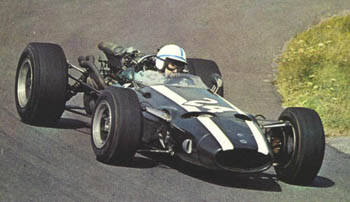 Within a few years of the release of the film, Clark, Bandini, Rindt and Schlesser would all be dead from race-related accidents. Another happenstance in 1966 was that the real Honda Formula One car was in its second year and had only one win to date, but in the Movie "Grand Prix", the fledgling Japanese "Yamura" quasi-Honda (driven by American Pete Aron, played by James Garner) is a featured player, quickly making its mark in Formula One and, by the end of the movie, it is the white quasi-Honda car that wins the championship. Within a few years of the release of the film, Clark, Bandini, Rindt and Schlesser would all be dead from race-related accidents. Another happenstance in 1966 was that the real Honda Formula One car was in its second year and had only one win to date, but in the Movie "Grand Prix", the fledgling Japanese "Yamura" quasi-Honda (driven by American Pete Aron, played by James Garner) is a featured player, quickly making its mark in Formula One and, by the end of the movie, it is the white quasi-Honda car that wins the championship.
But as has been the case since the beginning of the sport, Ferrari is at the center of the film, as it is now and doubtless will be in Sylvester Stallone's movie. Unhappily for Frankenheimer, 1966 turned out to be a year in which (surprise) Ferrari was in turmoil, which must have played havoc with making the film. The Yves Montand character, Sarti, was clearly named to sound like the real lead Ferrari driver, Surtees, so that the ambient loudspeaker sounds from the "real" race would still be useable. But then in mid-season, Surtees had a dispute with Ferrari revolving around Le Mans and he quit the Ferrari team, ultimately ending up driving a Cooper-Maserati later on in the season. But by that time the die had been cast and "Sarti" remained the name of the lead Ferrari driver.
The tumult at Ferrari also led to the withdrawal of Ferrari from the 1966 British Grand Prix at Brands Hatch, which unfortunately was one of the main races chosen by Frankenheimer to showcase the sport and his film resplendent as it was with British marching bands and the atmospherics of a great racing circuit. It is plain from viewing the film that a mock start and a mock race had to be conducted for the British Grand Prix, incorporating the Ferrari's who "raced" at Brands Hatch that year although the real Ferrari team stayed home.
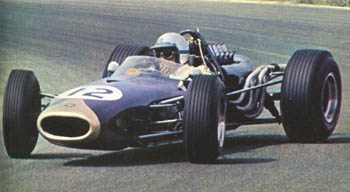 Indeed, since the Ferrari's were AWOL, it appears that a year-old Lotus or a Formula Two version thereof and an older Brabham BT19 were repainted red to look like Ferrari's for the shots taken of the pre-race grid activities and the Brands Hatch mock race. One of the "extras" who was an eyewitness to the filming of Grand Prix at Brands Hatch, Then-Race Marshal-Turned-Actor Graham Gosling, described the scene as follows in correspondence with me: Indeed, since the Ferrari's were AWOL, it appears that a year-old Lotus or a Formula Two version thereof and an older Brabham BT19 were repainted red to look like Ferrari's for the shots taken of the pre-race grid activities and the Brands Hatch mock race. One of the "extras" who was an eyewitness to the filming of Grand Prix at Brands Hatch, Then-Race Marshal-Turned-Actor Graham Gosling, described the scene as follows in correspondence with me:
"I spent the week after the British Grand Prix working for John Frankenheimer as a paid extra on the movie Grand Prix. A whole bunch of us BRSCC Marshals were invited to help out and play our roles, as what else, but Race Marshals.
"I'll never forget watching John Frankenheimer in action. What a dynamic director. I was enormously impressed with his energy and dedication to detail. James Garner was a blast, and because we had a bunch of very bad weather at Brands Hatch, we spent a lot of time with "Maverick" playing cards in the pits. Most of us were nervous about being caught on screen because we were supposed to be sick, and the bad weather meant that filming was very spotty. I think we stayed there all week.
"James Garner was a natural driver. The film crew used either Formula Three or Formula Two cars made to look like F1. If you remember in the movie they had a good looking young Italian stud [Antonio Sabato] who played one of the drivers, but in actual fact he was hopeless driving. So Frankenheimer told them to take off the nose of his car, they attached an A frame, and then hooked him to the back of the filming truck and literally dragged him around the track. The ensuing footage from the truck looked great - the Italian looked terrified - in fact he was!!"
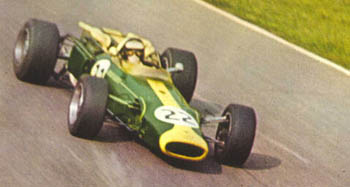 There were other curiosities in the filming of "Grand Prix" that bedeviled its producers. Bringing the 1966 Belgium Grand Prix at Spa to film must have been a nightmare for Frankenheimer since, as with the real 1998 Spa, the field in the real 1966 Spa was decimated by an accident in the rain before the first lap had been run, thus leaving the movie version of Spa 1966 with probably more cars competing in the mock race than competed in the real race. And while Ferrari and Surtees won the real 1966 Spa, James Garner and the quasi-Honda win Spa in the movie, a race the real Honda team chose not to compete in at all that year, preferring to concentrate on developing its new 3-litre car. There were other curiosities in the filming of "Grand Prix" that bedeviled its producers. Bringing the 1966 Belgium Grand Prix at Spa to film must have been a nightmare for Frankenheimer since, as with the real 1998 Spa, the field in the real 1966 Spa was decimated by an accident in the rain before the first lap had been run, thus leaving the movie version of Spa 1966 with probably more cars competing in the mock race than competed in the real race. And while Ferrari and Surtees won the real 1966 Spa, James Garner and the quasi-Honda win Spa in the movie, a race the real Honda team chose not to compete in at all that year, preferring to concentrate on developing its new 3-litre car.
The cars used to make "Grand Prix" are themselves an interesting story. In addition to the quasi-Ferraris at Brands Hatch, the white quasi-Honda Yamura cars were actually older ex-Clark Lotuses or ex-BRM's purchased by MGM, with disguised engine cowlings to make them appear different from the real Lotuses in the field. By a strange coincidence, one of the Lotus 33's used in the 1966 film (chassis no. R8) had in real life been crashed by Paul Hawkins a year earlier in the 1965 Monaco Grand Prix; Hawkins survived the crash.
The Ferrari's used by Sarti are sometimes inconsistent because in fact Ferrari used a Ferrari 246 Dino 2.4-litre V6 for Lorenzo Bandini in some races and a Ferrari 312 3-litre V12 for John Surtees and in "Grand Prix" they sometimes get mixed up; in the most famous marquee shots of the Ferrari on the Monza banking, several air ducts are apparent on the nose of the Ferrari 312, but in other scenes, the nose cone of a Ferrari 246 has no scoops at all or black tape used to imitate a scoop. And in come scenes, the mirrors on the Ferrari are red; in others, they are silver.
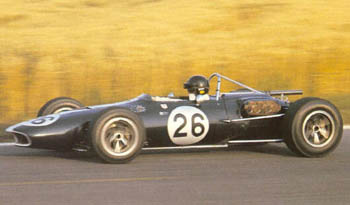 But these continuity errors are quibbles: the wonderful scene capturing a visit by James Garner to the Ferrari factory alone justifies seeing "Grand Prix" again; as the actors wander through the factory speaking their lines, they pass by what would now be millions of dollars of collector Ferrari Formula One cars and Ferrari 330 P3 Sports Cars of the period, lined up like soldiers, being tended to by the mechanics. Given the penchant for secrecy in Formula One, then and now, it is an extraordinary scene. Amazingly, the front entrance to the Ferrari factory shown in "Grand Prix" with the Cavallino restaurant across the street is virtually the same sight you would see today if you visited Maranello. But these continuity errors are quibbles: the wonderful scene capturing a visit by James Garner to the Ferrari factory alone justifies seeing "Grand Prix" again; as the actors wander through the factory speaking their lines, they pass by what would now be millions of dollars of collector Ferrari Formula One cars and Ferrari 330 P3 Sports Cars of the period, lined up like soldiers, being tended to by the mechanics. Given the penchant for secrecy in Formula One, then and now, it is an extraordinary scene. Amazingly, the front entrance to the Ferrari factory shown in "Grand Prix" with the Cavallino restaurant across the street is virtually the same sight you would see today if you visited Maranello.
It also appears that the real BRM team was obviously a key partner for Frankenheimer in making the film, along with Ferrari. Here too, though, the Formula One pedant will have a field day. BRM driver Jackie Stewart - Scottish tartan striped helmet and all - is played well by actor Brian Bedford, but Bedford looks more like Jimmy Clark than Stewart. Nonetheless, by combining the tartan helmet with a cloth face mask to protect the driver's face from stones, the resemblance to Jackie Stewart is carried off very successfully throughout the film.
Several BRM's were used in the film, both the real ones and the movie star BRM's, some of them used as film cars and incorporated into the pack for the mock races; two of the BRM's seem to have been destroyed in the art-imitating-life chicane accident where one BRM goes into the Monaco harbor and the other one climbs up onto a wall and comes crashing back down onto the quay next to the Monaco harbor.
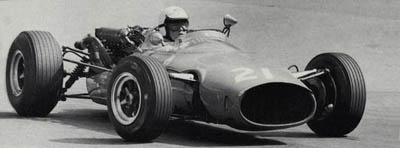 Here too, a few quibbles. The accident at the chicane must have been difficult and expensive to film but looks preposterous as a matter of physics. And here too a close eye can detect flaws. When James Garner's BRM is retrieved from the harbor of Monaco after crashing at the chicane early in the film with his BRM teammate, the mock-up of a BRM used in the scene clearly has no engine or transmission in it (which might explain why James Garner was having trouble shifting, which led to the chicane accident!). Here too, a few quibbles. The accident at the chicane must have been difficult and expensive to film but looks preposterous as a matter of physics. And here too a close eye can detect flaws. When James Garner's BRM is retrieved from the harbor of Monaco after crashing at the chicane early in the film with his BRM teammate, the mock-up of a BRM used in the scene clearly has no engine or transmission in it (which might explain why James Garner was having trouble shifting, which led to the chicane accident!).
Another prescient curiosity is that the real Owen Racing Organization BRM team in the movie is called the "Jordan" Racing Organization, at a time when Eddie Jordan was an 18 year-old! In a final irony, the very next year after "Grand Prix" was filmed, in the course of the 1967 Monaco Grand Prix, a real crash at the Monaco chicane ended up killing Lorenzo Bandini, who was trapped and incinerated as his Ferrari literally burned to the ground, in one of the most gruesome accidents to have occurred in Formula One.
The way the actual race footage was obtained is also interesting. According to Phil Hill (who appeared in Grand Prix as an actor and teammate to James Garner on the quasi-Honda Yamura team), he was allowed by race organizers to drive the first lap of the race to capture the in-car footage of the actual races we see in the film, which was then supplemented by mock race footage to create the races in the film (he even ended up passing Dan Gurney one time in the camera car).
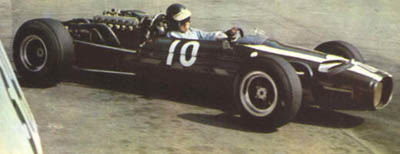 In addition, with Carroll Shelby's help, MGM had outfitted a high-powered GT40 and 7.0 litre Shelby Cobra to keep up with the Ferrari's, etc. and to film the mock race footage. The result is a tremendous cinematic achievement even seen 33 years later, made all the more impressive when it is considered how primitive the camera technology was at the time, decades before we had IMAX large format film or in-car camera systems as we know them. Indeed, "Grand Prix" won three Academy Awards (Oscars) for Sound, Editing and Sound Effects. In addition, with Carroll Shelby's help, MGM had outfitted a high-powered GT40 and 7.0 litre Shelby Cobra to keep up with the Ferrari's, etc. and to film the mock race footage. The result is a tremendous cinematic achievement even seen 33 years later, made all the more impressive when it is considered how primitive the camera technology was at the time, decades before we had IMAX large format film or in-car camera systems as we know them. Indeed, "Grand Prix" won three Academy Awards (Oscars) for Sound, Editing and Sound Effects.
But the races at Monza and Monaco are the real visual feasts of the film. The film opens with the Monaco Grand Prix and footage of the glamorous principality; the integration of the real 1966 Monaco race into the make-believe movie race is a true tour de force. The mid-1960's European flavor of the whole film is particularly tangible in the Monaco sequences. It should be remembered that "Grand Prix" was filmed just as society was on the cusp between the ultimate playing out of the fashions, tastes and designs of the 1950's and the cultural upheaval that was to come by 1968 and in the Monaco scenes the movie captures that cultural moment perfectly.
Again in the Monaco race, however, the real race did not cooperate with the script. In the film the two BRM's tangle and crash at Monaco, putting both of them out and leaving the Ferrari finishing first. In the actual 1966 Monaco Grand Prix, BRM had a banner day, with Jackie Stewart finishing first and teammate Graham Hill finishing third; Bandini's Ferrari 246 Dino finished second.
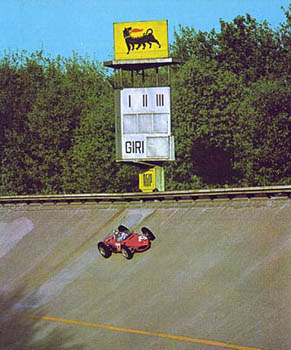 The Ferrari 312 driven by Surtees was out with gearbox failure after 14 laps (this was the first race of the new 3-litre formula) but Frankenheimer used those few laps to their best advantage in the fabulous helicopter shots which follow Surtees along the Mediterranean waterfront and into the tunnel in the opening minutes of "Grand Prix". The Ferrari 312 driven by Surtees was out with gearbox failure after 14 laps (this was the first race of the new 3-litre formula) but Frankenheimer used those few laps to their best advantage in the fabulous helicopter shots which follow Surtees along the Mediterranean waterfront and into the tunnel in the opening minutes of "Grand Prix".
At Monza, the now-unused-and-threatened-to-be-destroyed Monza banking takes center stage. In real life, the Monza banking has not been incorporated into a Formula One race since the ill-starred 1961 race, but in 1966 Frankenheimer got access to the old banking to film some of the most memorable racing sequences. Indeed, the best footage of the mock 1966 Monza race is on the banking and incredibly the filming technique used is even more intimate than the fabulous in-car footage we have come to accept as the norm in Formula One coverage.
In Frankenheimer's coverage of Monaco, the setting predominates over the cars and the racing; in his Monza coverage, the cars come to the fore. The sounds of downshifting, the slipstreaming on the straights, the working of the suspension and the pounding the cars took on the Monza banking are all captured in a magnificent mock race that ends in the tragic death of Ferrari driver Sarti and the unexpected victory of James Garner in the quasi-Honda, certainly the high-water mark for Honda in Formula One, if only on film.
In orchestrating this photo-finish at Monza with the quasi-Honda winning, Frankenheimer was again ahead of his time: the very next year, in 1967, the actual Honda RA300 3-litre car dubbed the "Hondola" and driven by Surtees beat Jack Brabham at Monza by two-tenths of a second, Honda's last victory in Formula One.
As lucky as Frankenheimer was in picking a great year to do the film, he did miss a few tricks. The U.S. Grand Prix gets short shrift in the film by the cinematic device of showing us a trophy won by the BRM team at Watkins Glen and a passport entry from the drivers' passport indicating a visit to New York. In fact, Jimmy Clark had a historic win for both Lotus and BRM at Watkins Glen in 1966 in the same car: the only time the fiendish BRM H16 engine (in Clark's Lotus because there was no 3-litre Climax engine) ever won a race.
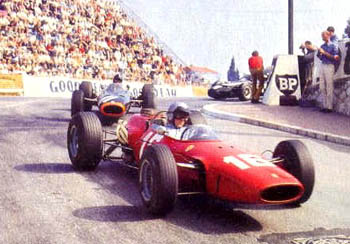 Since Watkins Glen is a European-like circuit, it is a shame and our loss now that for budgetary or other reasons, the "Grand Prix" production crew never made it to upstate New York to film that particular contribution to the time capsule. Since Watkins Glen is a European-like circuit, it is a shame and our loss now that for budgetary or other reasons, the "Grand Prix" production crew never made it to upstate New York to film that particular contribution to the time capsule.
Indeed, although brief flashes of twice World Champion Jimmy Clark and his car appear in the film, the single biggest curiosity of "Grand Prix" given Clark's prominence at that time (and Colin Chapman's legendary nose for money) is that Team Lotus and Clark are not featured in the film, thus robbing us of more race footage of The Flying Scot and the spindly green and yellow Lotus which he made so famous. I suspect that the out takes from "Grand Prix" and the footage Phil Hill accumulated during the real races would make a marketable video lo these many years later.
The other orphan driver in Grand Prix is Jack Brabham, who appears from time to time but is not featured in the film. In 1966, the Grand Prix season in reality belonged to Black Jack, when he won the World Championship for the third time, that year in a car of his manufacture, with his teammate Denis Hulme finishing fourth overall. You can't think of everything. All in all, although Frankenheimer guessed wrong on who won the races he featured, the mixing and matching of the real with the imagined is done so well that the "Grand Prix" 1966 make believe season is now as much a part of Formula One history as the actual 1966 season.
Seen again from the distance of 33 years, "Grand Prix" stands up well, both as a cinematic achievement and as an archive of an era that turned out to be well worth preserving.
Will history repeat itself with Sylvester Stallone's Formula One film, which is rumored to be going into production in either the 1999 or the 2000 season? Again, by serendipity, Stallone is fortunate to be filming in yet another Golden Age of Formula One, when there are a multiplicity of interesting cars, drivers and racing circuits to choose from as grist for the film. Even Honda will be back by Y2K, to complete the parallels.
Next issue - Part II: what Stallone should do with these fortuitous circumstances so that his film will also stand the test of time.
| 








